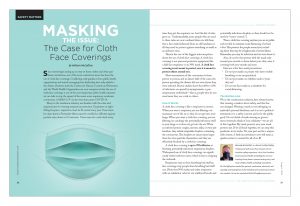Masking the Issue: The Case for Cloth Face Coverings
Since states began easing up on stay-at-home orders and other pandemic restrictions, one of the most contentious issues has been the use of cloth face coverings. Conflicting early guidance from public health organizations and mixed messaging from leadership have only added to the debate. However, both the Centers for Disease Control and Prevention and the World Health Organization are now unequivocal that the use of cloth face coverings is one of the most important public health measures we can take to stop the spread of the severe acute respiratory syndrome coronavirus 2 (SARS-CoV-2), the virus that causes COVID-19.
Many in the insulation industry are familiar with the rules and requirements for wearing respiratory protection. Employees in tight-fitting facepiece respirators must be fit-tested every year. Users must be clean shaven. Particulate filters must be certified as effective against particle sizes down to 0.3 microns. Users must do a seal check every time they put the respirator on. And the list of rules goes on. Understandably, some people who are used to these rules are now confused when we tell them that a face mask fashioned from an old bandanna is all they need to protect against something as small as an airborne virus.
Therein lies one of the biggest misconceptions about the use of cloth face coverings. A cloth face covering is not personal protective equipment like a half face respirator or an N95 mask. A cloth face covering is not meant to protect you; it is meant to protect others around you.
Most transmission of the coronavirus is from person to person, and in almost half of the cases, the person spreading the disease did not even know they were infected. Recent studies show that 40% to 45% of infections are spread by asymptomatic or pre-symptomatic individuals—that is, people who do not even know they are a risk to others.
How it Works
A cloth face covering is like a respirator in reverse. When you wear a respirator, you are filtering contaminants out of the air so they do not get into your lungs. When you wear a cloth face covering, you are filtering (or catching) the potentially infectious stuff in your lungs so it does not get into the air. When an infected person coughs, sneezes, talks, or even just breathes, they exhale respirable droplets containing the coronavirus. The droplets are many times larger than the virus particles themselves, and they are effectively blocked by a cloth face covering.
A cloth face covering is up to 99% effective at blocking potentially infectious respiratory droplets. Widespread use of cloth face coverings can significantly reduce infection rates, which is key to stopping the outbreak.
Respirators stop us from breathing bad stuff in; face coverings stop people from breathing bad stuff out. [Note that N95 masks and other respirators with an exhalation valve let out unfiltered breath and potentially infectious droplets, so they should not be used for “source control.”]
Wear a cloth face covering anytime you are in public and not able to maintain social distancing of at least 6 feet. This protects the people around you, including those that may be at higher risk of severe illness. Remember, you may be infectious and not even know it.
Also, do not be that person with the mask only around your mouth or down below your chin; wear it covering both your mouth and nose.
Here are a few face mask precautions:
- Do not put masks on people who have trouble breathing or are incapacitated,
- Do not put masks on children under 2 years old, and
- Do not use face masks as a substitute for social distancing.
The Bottom Line
We in the construction industry, have always known that wearing a mask is about safety, and that has not changed. Wearing a mask is not infringing on anybody’s personal freedoms, and it is not a political statement; it is a safety concern and is for the public good. Do not think of mask wearing as government overreach; think of it as solidarity—we are all in this together. My mask protects you; your mask protects me. If we all band together, we can stop this pandemic in its tracks. Do your part and be a responsible citizen. A little inconvenience now will mean a quicker return to normal for all of us.
Copyright statement
This article was published in the August 2020 issue of Insulation Outlook magazine. Copyright © 2020 National Insulation Association. All rights reserved. The contents of this website and Insulation Outlook magazine may not be reproduced in any means, in whole or in part, without the prior written permission of the publisher and NIA. Any unauthorized duplication is strictly prohibited and would violate NIA’s copyright and may violate other copyright agreements that NIA has with authors and partners. Contact publisher@insulation.org to reprint or reproduce this content.
Disclaimer: Unless specifically noted at the beginning of the article, the content, calculations, and opinions expressed by the author(s) of any article in Insulation Outlook are those of the author(s) and do not necessarily reflect the views of NIA. The appearance of an article, advertisement, and/or product or service information in Insulation Outlook does not constitute an endorsement of such products or services by NIA. Every effort will be made to avoid the use or mention of specific product brand names in featured magazine articles.

